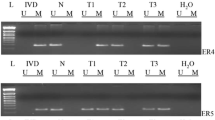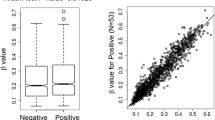Abstract
Introduction Oestrogen receptor alpha (ER alpha) is traditionally measured on all breast tumour specimens to identify those patients more likely to respond to anti-oestrogens. Progesterone receptor (PR) status has contributed useful information in defining more responsive subgroups. PR negativity may be a marker for increased signalling through growth factor receptor tyrosine kinase pathways. Progesterone acts through two PRs, PRA and PRB. PRB, the functionally active PR, can be silenced by promoter hypermethylation. Methods Following DNA and RNA extraction from 94 breast carcinomas, the methylation status of the PRB promoter was assessed by sodium bisulphite modification and methylation sensitive PCR (MSP). A quantitative realtime PCR analysis (QRTPCR) was used to determine the levels of PRB mRNA expression. Protein expression was evaluated immunohistochemically with a commercially available PRB antibody. Results 76% of the primary breast carcinoma samples demonstrated a methylated band for PRB. PRB methylation significantly compromised total PR immunohistochemistry (IHC) expression (P = 0.03). PRB mRNA correlated positively with total PR IHC (r = 0.58, P = 0.04), ER alpha IHC (P = 0.02), and tumour grade (P = 0.01). PRB protein expression was significantly associated with a number of favourable prognostic variables including smaller (P = 0.004) lower grade (P = 0.007), ER alpha IHC positive tumours (P < 0.001), and tumours with a low Nottingham Prognostic Index (NPI) (P = 0.0008). PRB mRNA levels were significantly associated with better overall survival (P = 0.04) in a univariate analysis. Conclusion The majority of tumours were methylated for PRB. This did not directly compromise PRB expression suggesting that other factors may down regulate the PR gene. When PRB was expressed, it correlated with good prognostic markers and better overall survival.



Similar content being viewed by others
References
Arpino G, Weiss H, Lee AV, Schiff R, De Placido S, Osbourne CK, Elledge R (2005) Estrogen receptor-positive, Progesterone receptor-negative breast cancer: association with growth factor receptor expression and tamoxifen resistance. J Natl Cancer Inst 97(17):1254–1261
Sartorius CA, Melville MY, Hovland AR, Tung L, Takimoto GS, Horwitz KB (1994) A third transactivation function (AF3) of human progesterone receptors located in the unique N-terminal segment of the B-isoform. Mol Endocrinol 8(10):1347–1360
Edwards DP, Wardell SE, Boonyaratanakornkit V (2002) Progesterone receptor interacting coregulatory proteins and cross talk with cell signaling pathways. J Steroid Biochem Mol Biol 83(1–5):173–186
Mulac-Jericevic B, Lydon JP, DeMayo FJ, Conneely OM (2003) Defective mammary gland morphogenesis in mice lacking the progesterone receptor B isoform. Proc Natl Acad Sci USA 100(17):9744–9749
Vegeto E, Shahbaz MM, Wen DX, Goldman ME, O’Malley BW, McDonnell DP (1993) Human progesterone receptor A form is a cell- and promoter-specific repressor of human progesterone receptor B function. Mol Endocrinol 7(10):1244–1255
Hopp TA, Weiss HL, Hilsenbeck SG, Cui Y, Allred DC, Horwitz KB, Fuqua SA (2004) Breast cancer patients with progesterone receptor PR-A-rich tumors have poorer disease-free survival rates. Clin Cancer Res 10(8):2751–2760
Richer JK, Jacobsen BM, Manning NG, Abel MG, Wolf DM, Horwitz KB (2002) Differential gene regulation by the two progesterone receptor isoforms in human breast cancer cells. J Biol Chem 277(7):5209–5218
Wajed SA, Laird PW, DeMeester TR (2001) DNA methylation: an alternative pathway to cancer. Ann Surg 234(1):10–20
Widschwendter M, Jones PA (2002) The potential prognostic, predictive, and therapeutic values of DNA methylation in cancer. Clin Cancer Res 8(1):17–21
Yang X, Yan L, Davidson NE (2001) DNA methylation in breast cancer. Endocr Relat Cancer 8(2):115–127
Lapidus RG, Ferguson AT, Ottaviano YL, Parl FF, Smith HS, Weitzman SA, Baylin SB, Issa JP, Davidson NE (1996) Methylation of estrogen and progesterone receptor gene 5′ CpG islands correlates with lack of estrogen and progesterone receptor gene expression in breast tumors. Clin Cancer Res 2(5):805–810
Sasaki M, Dharia A, Oh BR, Tanaka Y, Fujimoto S, Dahiya R (2001) Progesterone receptor B gene inactivation and CpG hypermethylation in human uterine endometrial cancer. Cancer Res 61(1):97–102
Sasaki M, Tanaka Y, Perinchery G, Dharia A, Kotcherguina I, Fujimoto S, Dahiya R (2002) Methylation and inactivation of estrogen, progesterone, and androgen receptors in prostate cancer. J Natl Cancer Inst 94(5):384–390
Elston CW, Ellis IO (1991) The value of histological grade in breast cancer: experience from a large study with long term follow up. Histopathology 19:403–410
Blamey R (1996) The design and clinical use of the Nottingham Prognostic Index in breast cancer. Breast 5:156–157
Kiani J, Khan A, Khawar H, Shuaib F, Pervez S (2006) Estrogen receptor α negative and Progesterone receptor positive breast cancer:lab error or real entity. Pathol Oncol Res 12(4):223–227
Dowsett M, on behalf of the ATAC Trialist group (2003) Analysis of time to recurrence in the ATAC (Arimidex, tamoxifen, alone or in combination) trial according to estrogen receptor and progesterone receptor status. Breast Cancer Res Treat 82(Suppl 1):S7
Osborne CK, Schiff R, Arpino G, Lee AS, Hilsenbeck VG (2005) Endocrine responsiveness: Understanding how progesterone receptor can be used to select endocrine therapy. Breast 14:458–465
Punglia RS, Kuntz KM, Winer EP, Weeks JC, Burstein HJ (2006) The impact of tumor Progesterone receptor status on optimal adjuvant endocrine therapy for postmenopausal patients with early stage breast cancer A decision analysis. Cancer 106:2576–2582
Veronesi U, Boyle P, Goldhirsch A, Orecchia R, Viale G (2005) Breast cancer. Lancet 365(9472):1727–1741
Lakhani SR (1999). The pathology of familial breast cancer: morphological aspects. Breast Cancer Res 1(1):31–35
Ma Y, Katiyar P, Jones LP, Fan S, Zhang Y, Furth PA, Rosen EM (2006) The breast cancer susceptibility gene BRCA1 regulates progesterone receptor signaling in mammary epithelial cells. Mol Endocrinol 20(1):14–34
Acknowledgement
The present study was supported by a Mater Research Grant.
Author information
Authors and Affiliations
Corresponding author
Rights and permissions
About this article
Cite this article
Mc Cormack, O., Chung, W.Y., Fitzpatrick, P. et al. Progesterone receptor B (PRB) promoter hypermethylation in sporadic breast cancer. Breast Cancer Res Treat 111, 45–53 (2008). https://doi.org/10.1007/s10549-007-9757-7
Received:
Accepted:
Published:
Issue Date:
DOI: https://doi.org/10.1007/s10549-007-9757-7




